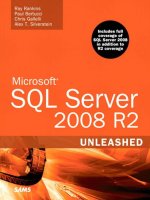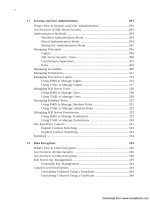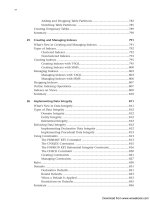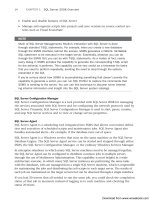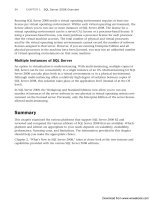Microsoft SQL Server 2008 R2 Unleashed- P8 pptx
Bạn đang xem bản rút gọn của tài liệu. Xem và tải ngay bản đầy đủ của tài liệu tại đây (225.7 KB, 10 trang )
ptg
24
CHAPTER 1 SQL Server 2008 Overview
SQL Server 2008 Standard Edition includes the following features:
. CLR procedures, functions, and data types
. SQL Server Analysis Services
. Service Broker
. Reporting Services
. SQL Server Integration Services
. Full-Text Search
. Built-in XML support
. Spatial Indexes
. SQL Server Profiler and performance analysis tools
. SQL Server Management Studio
. Policy Based Management
. Replication
. Two-node failover clustering
. Database mirroring (safety full mode only)
. Log shipping
. Backup Compression (available in R2 only)
The Standard Edition can be installed on any of the Windows 2003 SP2 and Windows 2008
Server platforms, as well as Windows XP Professional, Windows Vista Ultimate, Enterprise,
or Business Editions, and Windows 7 Ultimate, Enterprise, or Professional Editions.
The Standard Edition should meet the needs of most departmental and small- to mid-sized
applications. However, if you need more scalability, availability, advanced security or
performance features, or comprehensive analysis features, you should implement the
Enterprise Edition of SQL Server 2008.
SQL Server 2008 Enterprise Edition
The Enterprise Edition of SQL Server 2008 is the most comprehensive and complete edition
available. It provides the most scalability and availability of all editions and is intended for
systems that require high performance and availability, such as large-volume websites, data
warehouses, and high-throughput online transaction processing (OLTP) systems.
SQL Server 2008 Enterprise Edition supports as much memory and as many CPUs as
supported by the operating system on which it is installed. It can be installed on any of
the Windows 2003 SP2 and Windows 2008 Server platforms.
In addition, SQL Server 2008 Enterprise Edition provides performance enhancements, such
as parallel queries, indexed views, and enhanced read-ahead scanning.
Download from www.wowebook.com
ptg
25
SQL Server 2008 R2 Editions
Which version is right for you? The next section explores the feature sets of Enterprise
and Standard Editions so you can decide which one provides the features you need.
Differences Between the Enterprise and Standard Editions of SQL Server
For deploying SQL Server 2008 in a server environment, either the Standard Edition or
Enterprise Edition of SQL Server is a logical choice. To help you decide between the two
editions, Table 1.1 compares the major features that each edition supports.
1
TABLE 1.1 SQL Server 2008 Feature Comparison: Enterprise and Standard Editions
Feature Enterprise
Edition
Standard Edition
Max number of CPUs 8 4
64-bit support Yes Yes
CLR runtime integration Yes Yes
Full-Text Search Yes Yes
Native XML Support Yes Yes
FILESTREAM Support Yes Yes
Spatial Data Support Yes Yes
SQL Server Integration Services Yes Yes
Database Mail Yes Yes
Policy Based Management Yes Yes
SQL Profile Yes Yes
Integration Services with Basic
Transforms
Yes Yes
Integration Services with Advanced
Data Mining and Cleansing
Transforms
Yes No
Star Join Query Optimization Yes No
Change Data Capture Yes No
Service Broker Yes Yes
Reporting Services Yes Yes
Replication Yes Yes
Log Shipping Yes Yes
Database mirroring Yes Yes (Single REDO thread with Safety FULL
only)
Download from www.wowebook.com
ptg
26
CHAPTER 1 SQL Server 2008 Overview
TABLE 1.1 SQL Server 2008 Feature Comparison: Enterprise and Standard Editions
Feature Enterprise
Edition
Standard Edition
Database snapshots Yes No
Indexed views Yes Yes (Can be created, but automatic matching
by Query Optimizer not supported)
Updatable distributed partitioned
views
Yes No
Table and index par titioning Yes No
Online index operations Yes No
Parallel index operations Yes No
Parallel DBCC Yes No
Online page and file restoration Yes No
Fast Recovery Yes No
Data Compression Yes No
Compressed Backups Yes Yes
Resource Governor Yes No
Fine Grained Encryption Yes No
Transparent Data Encr yption Yes No
Failover clustering Yes Yes (2-node only)
Multiple-instance support Yes (50
instances
maximum)
Yes (16 instances maximum)
PowerPivot for SharePoint Yes (R2 only) No
Application and Multi-Server
Management (R2 Only)
Yes Yes (as a managed instance only)
Other SQL Server 2008 Editions
The Standard and Enterprise Editions of SQL Server 2008 are intended for server-based
deployment of applications. In addition, the following editions are available for other
specialized uses:
. Workgroup Edition
. Developer Edition
. Web Edition
Download from www.wowebook.com
ptg
27
SQL Server 2008 R2 Editions
1
. Express Edition
. Compact Edition
Workgroup Edition
SQL Server 2008 Workgroup Edition is intended for small organizations that need a data-
base with no limits on database size or number of users but may not need the full capabil-
ities of the Standard Edition. SQL Server 2008 Workgroup Edition can be used as a
front-end web server or for departmental or branch office applications.
Workgroup Edition includes most of the core database features and capabilities of the SQL
Server Standard Edition except for the following:
. It is limited to two CPUs and a maximum of 4GB of memory.
. It does not support failover clustering.
. Database mirroring support is limited to being a witness only.
. It does not include Analysis Services.
. It provides limited support for Integration Services and Reporting Services features.
Workgroup Edition can be installed in any of the following environments:
. Any Windows 2003 Server editions
. Any Windows 2008 Server editions
. Windows 7
. Windows Vista
. Windows XP
Developer Edition
The Developer Edition of SQL Server 2008 is a full-featured version intended for develop-
ment and end-user testing only. It includes all the features and functionality of Enterprise
Edition, at a much lower cost, but the licensing agreement prohibits production deploy-
ment of databases using Developer Edition.
To provide greater flexibility during development, Developer Edition can be installed in
any of the following environments.
. Any Windows 2003 Server editions
. Any Windows 2008 Server editions
. Windows 7
. Windows Vista
. Windows XP
Web Edition
SQL Server 2008 Web Edition is a lower total-cost-of-ownership option, similar to the
Workgroup Edition, but intended for small- to large-scale web hosts and websites.
Download from www.wowebook.com
ptg
28
Web Edition includes most of the core database features and capabilities of the SQL Server
Standard Edition with the following key differences:
. It is limited to a maximum of 4 CPUs.
. Unlike the Workgroup Edition, memory in this edition is constrained only by the OS
maximum memory limits.
. It does not support failover clustering.
. Database mirroring support is limited to being a witness only.
. It does not include Analysis Services.
. It includes only the basic version of SQL Server Management Studio (which lacks
advanced features such as IntelliSense and version control support).
. It provides limited support for Integration Services and Reporting Services features.
Web Edition can be installed in any of the following environments.
. Any Windows 2003 Server editions
. Any Windows 2008 Server editions
. Windows 7
. Windows Vista
. Windows XP
Express Edition
SQL Server Express Edition is a free, lightweight, embeddable, and redistributable version
of SQL Server 2008. It includes a stripped-down version of SQL Server Management
Studio, called SQL Server Management Studio Express, for easily managing a SQL Server
Express instance and its databases. The Express Edition of SQL Server 2008 is intended for
users who are running applications that require a locally installed database, often on
mobile systems, and who spend at least some time disconnected from the network. The
core database engine of Express Edition is the same as the other SQL Server editions, so as
your needs grow, your applications seamlessly work with the rest of the SQL Server
product family.
The Express Edition can be installed in any of the following environments:
. Any Windows 2003 Server editions
. Any Windows 2008 Server editions
. Windows 7
. Windows Vista
. Windows XP
Express Edition supports most of the same features as the Workgroup Edition, with the
following exceptions:
CHAPTER 1 SQL Server 2008 Overview
Download from www.wowebook.com
ptg
29
SQL Server 2008 R2 Editions
1
. It is limited to using a maximum of one CPU and 1GB of memory.
. It limits the maximum database size to 4GB.
. It does not include Full-Text Search, Reporting Services, or Analysis Services.
. It does not include SQL Server Integration Services.
. It supports Service Broker as a client only.
. It does not include SSMS.
. It can participate in replication only as a subscriber.
If you need a bit more than the Express Edition offers, but not as much as the Workgroup
Edition, Microsoft also provides the Express Edition with Advanced Services. The Express
Edition with Advanced Services includes support for Full-Text Search and limited support
of Reporting Services for web reporting.
SQL Server Compact 3.5 Edition
SQL Server Compact 3.5 is a free, embedded version of SQL Server intended for building stand-
alone and occasionally connected applications for mobile devices, desktops, and web clients on
Windows platforms. The Compact 3.5 Edition provides general T-SQL compatibility and a cost-
based Query Optimizer similar to that in SQL Server 2008. Developers who are familiar with
SQL Server 2008 should feel comfortable developing for SQL Server Compact 3.5.
SQL Server Compact 3.5 Edition has a small footprint, requiring only about 2–3MB. It can
connect directly with a SQL Server 2008 database through remote execution of T-SQL
statements, and it also supports replication with SQL Server 2008 databases as a merge
replication subscriber so that data can be accessed and manipulated offline and synchro-
nized later with a server-based version of SQL Server 2008.
SQL Server 2008 R2 Premium Editions
SQL Server 2008 R2 introduces two new premium editions to meet the needs of large-scale
datacenters and data warehouses:
. SQL Server 2008 R2 Datacenter
. SQL Server 2008 R2 Parallel Data Warehouse
SQL Server 2008 R2 Datacenter Edition is built on SQL Server 2008 R2 Enterprise and is
designed to deliver a high-performing data platform that provides the highest levels of
scalability for large application workloads, virtualization and consolidation, and manage-
ment for an organization’s database infrastructure. The Datacenter Edition provides the
following key features:
. Application and Multi-Server Management for enrolling, gaining insights into, and
managing over 25 instances
. Highest virtualization support for maximum ROI on consolidation and virtualization
. High-scale complex event processing with SQL Server StreamInsight
Download from www.wowebook.com
ptg
30
. Support for more than 8 processors and up to 256 logical processors for highest
levels of scale
. Support for memory limits up to the OS maximum
SQL Server 2008 R2 Parallel Data Warehouse Edition is a highly scalable data warehouse
appliance-based solution that delivers performance at low cost through a massively paral-
lel processing (MPP) architecture and compatibility with hardware partners providing the
ability to scale your data warehouse to tens and hundreds of terabytes. Following are some
key features of the Parallel Data Warehouse Edition:
. Tens to hundreds of terabytes enabled by MPP architecture
. Advanced data warehousing capabilities such as Star Join Queries and Change Data
Capture
. Integration with SSIS, SSRS, and SSAS
. Support for the industry standard data warehousing hub and spoke architecture and
parallel database copy
SQL Server Licensing Models
In addition to feature sets, one of the determining factors in choosing a SQL Server
edition is cost. With SQL Server 2008, Microsoft provides two types of licensing models:
processor-based licensing and server-based licensing.
Processor-based licensing requires a single license for each physical CPU in the machine
that is running a Microsoft Server product. This type of license includes unlimited client
device access. Additional server licenses, seat licenses, and Internet connector licenses are
not required. You must purchase a processor license for each installed processor on the
server on which SQL Server 2008 will be installed, even if some processors will not be used
for running SQL Server. The only exception is for systems with 16 or more processors that
allow partitioning of the processors into groups so the SQL Server software can be dele-
gated to a subset of the processors.
NOTE
For licensing purposes, Microsoft bases the number of CPUs in a machine on the num-
ber of CPU sockets on the motherboard, not the number of cores on the CPU chip
itself. Thus, although a dual-core or quad-core processor chip may appear to the operat-
ing system as two or four CPUs, at the time of this writing, each of these types of
chips is still considered a single CPU for licensing purposes if it occupies only a single
CPU socket on the motherboard.
For those who prefer the more familiar server/client access license (CAL), or for environ-
ments in which the number of client devices connecting to SQL Server is small and known,
two server/CAL-based licensing models are also available:
CHAPTER 1 SQL Server 2008 Overview
Download from www.wowebook.com
ptg
31
SQL Server Licensing Models
1
. Device CALs—A device CAL is required for a device (for example, PC, workstation,
terminal, PDA, mobile phone) to access or use the services or functionality of
Microsoft SQL Server. The server plus device CAL model is likely to be the more cost-
effective choice if there are multiple users per device (for example, in a call center).
. User CALs—A SQL server user CAL is required for a user (for example, an employee,
a customer, a partner) to access or use the services or functionality of Microsoft SQL
Server. The server plus user CAL model is likely to be more cost effective if there are
multiple devices per user (for example, a user who has a desktop PC, laptop, PDA,
and so forth).
The server/CAL licensing model requires purchasing a license for the computer running
SQL Server 2008 as well as a license for each client device or user that accesses any SQL
Server 2008 installation. A fixed number of CALs are included with a server license and
the server software. Additional CALs can be purchased as needed.
Server/per-seat CAL licensing is intended for environments in which the number of clients
per server is relatively low, and access from outside the company firewall is not required.
Be aware that using a middle-tier or transaction server that pools or multiplexes database
connections does not reduce the number of CALs required. A CAL is still required for each
distinct client workstation that connects through the middle tier. (Processor licensing
might be preferable in these environments due to its simplicity and affordability when the
number of clients is unknown and potentially large.)
The pricing listed in Table 1.2 is provided for illustrative purposes only and is based on
pricing available at the time of publication. These estimated retail prices are subject to
change and might vary from reseller pricing.
TABLE 1.2 SQL Server 2008 R2 Estimated Retail Pricing
Licensing Option Enterprise
Edition
Standard
Edition
Workgroup
Edition
Parallel Data Warehouse
and Datacenter Editions
Processor Licensing $28,749
per proces-
sor
$7,499 per
processor
$3,899 per
processor
$57,498 per processor
Server/per-seat CAL
license with 5 workgroup
CALs
N/A N/A $739 N/A
Server/per-seat CAL
license with 5 CALs
N/A $1,849 N/A N/A
Server/per-seat CAL
license with 25 CALs
$13,969 N/A N/A N/A
Download from www.wowebook.com
ptg
32
Web Edition Licensing
The Express Edition of SQL Server 2008 is available via free download from www.
microsoft.com/sql. Developers can redistribute it with their applications at no cost by
simply registering for redistribution rights with Microsoft. The Express Edition does not
require a CAL when it is used on a standalone basis. If it connects to a SQL Server instance
running Enterprise Edition, Standard Edition, or Workgroup Edition, a separate user or
device CAL is required for the device running Express Edition unless the SQL Server
instance it connects to is licensed using the per-processor model.
Developer Edition Licensing
The Developer Edition of SQL Server 2008 is available for a fixed price of $50. The
Developer Edition is licensed per developer and must be used for designing, developing,
and testing purposes only.
Express Edition Licensing
The Express Edition of SQL Server 2008 is available via free download from www.
microsoft.com/sql. Developers can redistribute it with their applications at no cost by
simply registering for redistribution rights with Microsoft. The Express Edition does not
require a CAL when it is used on a standalone basis. If it connects to a SQL Server instance
running Enterprise Edition, Standard Edition, or Workgroup Edition, a separate user or
device CAL is required for the device running Express Edition unless the SQL Server
instance it connects to is licensed using the per-processor model.
Compact Edition 3.5 Licensing
SQL Server 2008 Mobile Edition is available as a downloadable development product for
mobile applications. You can deploy SQL Server Mobile to an unlimited number of mobile
devices if they operate in standalone mode (that is, the device does not connect to or use
the resources of any SQL Server system not present on the device). If the device connects
to a SQL Server instance that is not on the device, a separate user or device CAL is
required unless the SQL Server instance it connects to is licensed using the per-processor
model.
Choosing a Licensing Model
Which licensing model should you choose? Per-processor licensing is generally required in
instances in which the server will be accessed via the Web. This type of licensing includes
servers used in Internet situations or servers that will be accessed from both inside and
outside an organization’s firewall. Per-processor licensing might also be appropriate and
cost effective for internal environments in which there are a very large number of users in
relation to the number of SQL Server machines. An additional advantage to the per-
processor model is that it eliminates the need to count the number of devices connecting
to SQL Server, which can be difficult to manage on an ongoing basis for a large organiza-
tion.
CHAPTER 1 SQL Server 2008 Overview
Download from www.wowebook.com
ptg
33
SQL Server Licensing Models
1
Using the server/per-seat CAL model is usually the most cost-effective choice in internal
environments in which client-to-server ratios are low.
Mixing Licensing Models
You can mix both per-processor and server/CAL licensing models in your organization. If
the Internet servers for your organization are segregated from the servers used to support
internal applications, you can choose to use processor licensing for the Internet servers
and server/CAL licensing for internal SQL Server instances and user devices.
Keep in mind that you do not need to purchase CALs to allow internal users to access a
server already licensed via a processor license: The processor licenses allow access to that
server for all users.
Passive Server/Failover Licensing
In SQL Server 2008, two or more servers can be configured in a failover mode, with one
server running as a passive server so that the passive server picks up the processing of the
active server only in the event of a server failure. SQL Server 2008 offers three types of
failover support:
. Database mirroring
. Failover clustering
. Log shipping
If your environment uses an active/passive configuration in which at least one server in
the failover configuration does not regularly process information but simply waits to pick
up the workload when an active server fails, no additional licenses are required for the
passive server. The exception is if the failover cluster is licensed using the per-processor
licensing model and the number of processors on the passive server exceeds the number
of processors on the active server. In this case, additional processor licenses must be
acquired for the number of additional processors on the passive computer.
In an active/active failover configuration, all servers in the failover configuration regularly
process information independently unless a server fails, at which point one server or more
takes on the additional workload of the failed server. In this environment, all servers must
be fully licensed using either per-processor licensing or server/CAL licensing. Keep in mind
that in some log shipping and database mirroring configurations, the standby (passive)
server can be used as a read-only reporting server installation. Under this usage, the
standby server is no longer “passive” and must be licensed accordingly.
Virtual Server Licensing
Virtualization is defined broadly as the running of software on a “virtual environment.” A
virtual environment exists when an operating system is somehow emulated (that is, does
not run directly on the physical hardware). When you’re running virtualization software
on a system, one or several applications and their associated operating systems can run on
one physical server inside their respective virtual environments.
Download from www.wowebook.com
